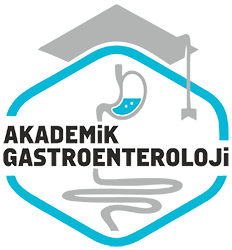Nisan 2022
Prematüre bebeklerde konjenital hipotiroidi ve nekrotizan enterokolit ilişkisi
Congenital hypothyroidism and necrotizing enterocolitis in infants born prematurely
- Ana Sayfa
- Sayılar
- Nisan 2022
- Prematüre bebeklerde konjenital hipotiroidi ve nekrotizan enterokolit ilişkisi...
Özet
ÖZET • Giriş ve Amaç: Hipotiroidinin gastrointestinal sistem üzerine olumsuz etkisi vardır. Konjenital hipotiroidinin nekrotizan enterokolit ile ilişkisi bilinmemektedir. Çalışmamızda çok düşük dogum agirlikli (< 1500 g) prematürelerde konjenital hipotiroidi ve nekrotizan enterokolit ile ilişkisinin değerlendirilmesi amaçlanmıştır. Gereç ve Yöntem: Çalışmamıza < 1500 g dogan prematüre bebekler retrospektif olarak dahil edildi. Konjenital hipotiroidi olan ve olmayan gruplar nekrotizan enterokolit gelisimi, demografik ve klinik özellikler açısından karsilastirildi. Ayrıca nekrotizan enterokolit olan ve olmayan gruplar tiroid fonksiyon testleri açısından karsilastirildi. Bulgular: çalışmaya 26 konjenital hipotiroidi olan ve 600 konjenital hipotiroidi olmayan toplam 626 prematüre bebek (gestasyon haftasi 28.1 ± 1.2 hafta, dogum agirligi 1056 ± 228 g) dahil edildi. Alti yüz yirmi alti bebekte nekrotizan enterokolit (evre ? 2) sikligi %2.5 (n = 16) olarak tespit edildi. Konjenital hipotiroidi olan grupta gebelik haftasi ve dogum agirligi (27.2 ± 0.9 hafta ve 1007 ± 208 g) konjenital hipotiroidi olmayan gruba (28.1 ± 1.2 hafta ve 1075 ± 221 g) göre anlamli düşük bulundu (sırasıyla, p < 0.001, p = 0.035). Nekrotizan enterokolit gelisim sikligi konjenital hipotiroidi olan ve olmayan gruplar arasında benzerdi (sırasıyla, %3.8, %2.5, p = 0.415). diğer demografik ve klinik özellikler açısından gruplar arasında sonuçlar benzer saptandi (p > 0.05). Nekrotizan enterokolit olan ve olmayan gruplarda serbest tiroksin düzeyleri (sırasıyla: 1.08 ± 0.35 ng/dl ve 1.15 ± 0.26 ng/dl) ve tiroid stimülan hormon düzeyleri (sırasıyla: 3.9 ± 2.8 uIU/L ve 5.6 ± 4.5 uIU/L) açısından istatistiksel olarak anlamli fark tespit edilmedi (sırasıyla, p = 0.326, p = 0.061). Sonuç: Çalışmamızda çok düşük dogum agirlikli prematürelerde konjenital hipotiroidi ile nekrotizan enterokolit gelisimi arasında ilişki tespit edilmemıştır.
Abstract
ABSTRACT • Background and Aims: Hypothyroidism negatively impacts the gastrointestinal system. Moreover, the effect of congenitalhypothyroidism on necrotizing enterocolitis is unknown. This study aimed to determine the effect of congenital hypothyroidism on necrotizingenterocolitis in infants who were born prematurely and had very low birthweight (< 1500 g). Materials and Methods: This retrospective studyincluded infants who were born prematurely and weighed < 1500 g. In addition to the demographic and clinical characteristics of the patients, theprevalence values of necrotizing enterocolitis between the congenital hypothyroidism and non-congenital hypothyroidism groups were compared.Results of the thyroid function tests were also compared between these groups. Results: A total of 626 premature infants (gestational age, 28.1± 1.2 weeks; birthweight, 1056 ± 228 g), including 26 with congenital hypothyroidism and 600 without congenital hypothyroidism, were enrolled inthe study. The frequency of necrotizing enterocolitis (stage ? 2) was 2.5% (n = 16) among 626 infants. The gestational age and birthweight (27.2 ±0.9 weeks and 1007 ± 208 g, respectively) of the congenital hypothyroidism group were significantly lower than those in the non-congenital hypothyroidism group (28.1 ± 1.2 weeks and 1075 ± 221 g, respectively) (p < 0.001, p = 0.035, respectively). The incidence of necrotizing enterocolitiswas comparable between the congenital hypothyroidism and non-congenital hypothyroidism groups (3.8% and 2.5%, respectively, p = 0.415).Other demographic and clinical characteristics were also comparable (p > 0.05). In groups with and without necrotizing enterocolitis, no significantdifference was detected on the levels of fT4 (1.08 ± 0.35 ng/dL and 1.15 ± 0.26 ng/dL, respectively) and thyroid-stimulating hormone (3.9 ± 2.8µIU/L and 5.6 ± 4.5 µIU/L; p = 0.326 and p = 0.061, respectively). Conclusions: Our study did not find a relationship between congenital hypothyroidism and necrotizing enterocolitis development in infants who were born prematurely and had a very low birthweight.



